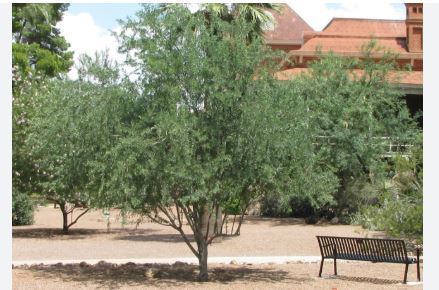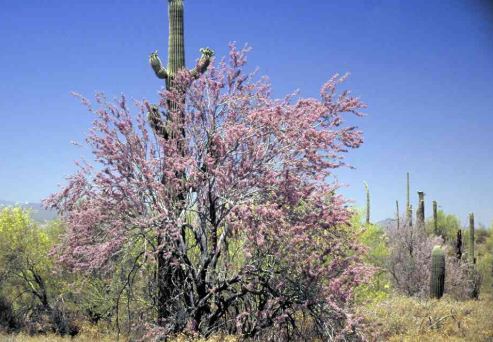
Desert Ironwood, scientifically known as Olneya tesota, belongs to the Fabaceae family, commonly referred to as the legume or pea family. It is the only species in the genus Olneya, making it monotypic. Classified as a perennial tree or large shrub, it falls within the subfamily Faboideae, characterized by its nitrogen-fixing capabilities.
Its taxonomic hierarchy places it in the order Fabales, class Magnoliopsida, and division Magnoliophyta, aligning it with other flowering plants. The species is uniquely adapted to arid environments, reflecting its specialized evolutionary niche within desert ecosystems.
Desert Ironwood is a slow-growing, evergreen or semi-deciduous tree, typically reaching 15–30 feet in height and width, with a broad, rounded canopy. Its bark is gray and fissured, becoming rougher with age. The compound, pinnate leaves are small, gray-green, and leathery, with 6–20 leaflets, often dropping in response to drought or cold. Spines or thorns, about 0.5 inches long, arm the branches.
In spring to early summer, it produces clusters of small, lavender to pinkish-purple, pea-like flowers, attracting pollinators like bees. The tree yields 1–2-inch-long, brown, woody pods containing 1–8 shiny, dark brown seeds. Its dense, iron-like wood, which sinks in water, is a hallmark trait, giving the tree its name.
Desert Ironwood is native to the Sonoran Desert of southwestern North America, spanning parts of southern Arizona and southeastern California in the United States, and Sonora, Baja California, and Baja California Sur in Mexico. It thrives in arid and semi-arid environments, typically found in desert washes, alluvial plains, and rocky slopes below 3,000 feet elevation.
The tree prefers well-drained, sandy, or gravelly soils and tolerates extreme heat and drought, making it a keystone species in its ecosystem. Its distribution is limited to frost-free or minimally frosty regions, where it supports diverse wildlife by providing shade, food, and habitat.
Desert Ironwood is hardy in USDA Zones 9–11, where minimum temperatures range from 20°F to 50°F. It is well-suited to warm, frost-free climates and struggles in areas with prolonged or severe freezes. In marginal zones (e.g., Zone 8), it may experience dieback or require protection during rare cold snaps. Its drought tolerance and heat resistance make it ideal for xeriscaping in appropriate zones, but it demands excellent drainage and full sun to thrive.
Desert Ironwood has multifaceted uses, rooted in both ecological and cultural significance. Ecologically, it serves as a nurse plant in the Sonoran Desert, fostering the growth of other species by providing shade and improving soil fertility through nitrogen fixation. Its dense canopy offers critical habitat for birds, insects, and mammals, while its seeds and pods are food sources for wildlife and, historically, indigenous peoples.
The wood, prized for its hardness and rich grain, is used by artisans for crafting knives, tools, and decorative items, though its scarcity limits large-scale use. Indigenous groups, such as the Seri and Tohono O’odham, have used the seeds for food (roasted or ground into flour) and the wood for fuel and construction. In landscaping, Desert Ironwood is valued for its low water needs and ornamental qualities, enhancing desert gardens with its attractive foliage and flowers. However, its slow growth and protected status in some areas encourage conservation over exploitation.

Desert Ironwood (Olneya tesota): Cultivation
Climate Suitability
Desert Ironwood thrives in USDA Zones 9–11, where minimum temperatures stay above 20°F (-6°C). It is best suited to hot, arid climates with low humidity, mimicking its native Sonoran Desert environment. Avoid planting in areas with frequent or severe freezes, as frost can damage young trees or cause dieback in mature ones.
Site Selection
Choose a location with full sun exposure, as Desert Ironwood requires at least 6–8 hours of direct sunlight daily for optimal growth. Select a site with excellent drainage, such as a slight slope or elevated area, to prevent waterlogging, which can lead to root rot.
Soil Requirements
Plant in well-drained, sandy, gravelly, or loamy soils with a pH range of 6.0–8.0. Desert Ironwood tolerates poor, rocky soils but does not perform well in heavy clay or compacted soils. Avoid amending soil with excessive organic matter, as this can retain too much moisture.
Planting
Sow seeds or plant nursery-grown saplings in spring after the last frost to ensure warm soil temperatures (70–85°F or 21–29°C). Soak seeds in warm water for 24 hours or scarify them to improve germination. Dig a hole twice as wide and as deep as the root ball, ensuring the root collar remains at soil level. Space trees 15–20 feet apart to accommodate their broad canopy.
Watering
Water deeply but infrequently during the first 1–2 years to establish a strong root system. Young trees may need watering every 1–2 weeks in summer, depending on soil drainage and climate. Once established, Desert Ironwood is highly drought-tolerant and typically relies on natural rainfall, requiring supplemental irrigation only during prolonged droughts.
Mulching
Apply a 2–3-inch layer of inorganic mulch, such as gravel or decomposed granite, around the base to conserve moisture, regulate soil temperature, and mimic its natural desert habitat. Keep mulch 3–4 inches away from the trunk to prevent rot. Avoid organic mulches like wood chips, which retain too much moisture.
Fertilization
Desert Ironwood generally does not require fertilization, as it fixes nitrogen through its roots. Over-fertilizing can lead to excessive foliage growth at the expense of hardiness. If soil is extremely nutrient-poor, apply a balanced, slow-release fertilizer (e.g., 10-10-10) sparingly in early spring during the establishment phase.
Pruning
Prune minimally to maintain a natural shape and remove dead, damaged, or crossing branches. Perform pruning in late winter or early spring before new growth begins. Avoid heavy pruning, as it can stress the slow-growing tree. Remove suckers or basal shoots to maintain a single trunk if desired.
Pest and Disease Management
Desert Ironwood is relatively pest- and disease-resistant but may occasionally attract aphids, spider mites, or scale insects. Monitor for infestations and use insecticidal soap or neem oil for control. Root rot, caused by overwatering or poor drainage, is the primary disease concern; ensure proper soil conditions to prevent it.
Propagation
Propagate Desert Ironwood primarily through seeds, as cuttings are difficult to root. Collect seeds from mature pods in late summer, scarify or soak them, and plant in well-draining soil. Germination can take 2–4 weeks. Nursery-grown saplings are often preferred for faster establishment in landscapes.
Growth Rate and Patience
Desert Ironwood is slow-growing, often taking 5–10 years to reach a modest height of 10–15 feet. Cultivators must be patient, as its growth rate reflects its adaptation to harsh desert conditions. Avoid overwatering or over-fertilizing in an attempt to speed growth, as this can harm the tree.
Landscape Use and Conservation
Use Desert Ironwood in xeriscapes, desert gardens, or as a focal point in low-water landscapes due to its attractive foliage, flowers, and ecological benefits. As a keystone species, it supports local wildlife, so consider its role in habitat restoration. Be aware of local regulations, as some areas protect native Desert Ironwood populations, limiting harvesting or transplanting from the wild.